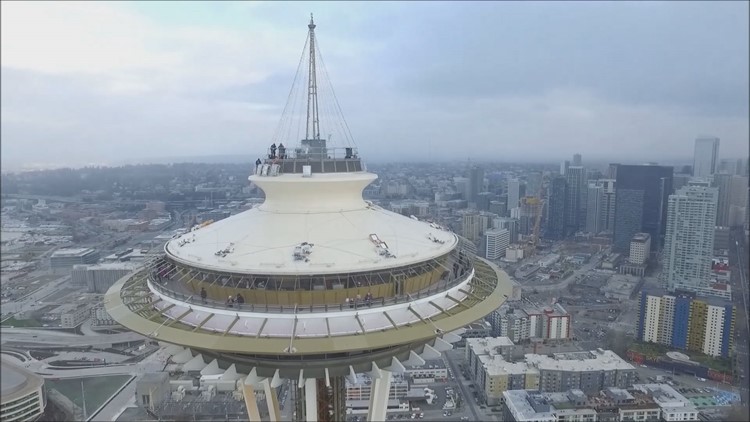Fifty-five years after its grand opening, Seattle's Space Needle will undergo a multi-million dollar and multi-year renovation.
The goal: to give visitors even more sweeping views of the city.
“The intent was to have a thrilling view over Seattle. It didn’t have pony walls and cages when it was built, so how do we get out of the way to get that thrilling view again?” said Karen Olson, the Space Needle’s chief marketing officer.
One of the biggest changes will be to the observation deck. It will become floor-to-ceiling glass, and the SkyCity Restaurant will have the first-ever rotating glass floor to provide a view straight to the ground, the Space Needle said in its announcement.
“I believe we’ll look back at this as a pivotal moment in the history of the Space Needle,” Jeff Wright, chairman, Space Needle LLC, said in a statement. “This project both connects us back to our roots, to the vision that my father and his partners had when they built the Space Needle in 1962, and guides us forward into the future for generations to enjoy.”
Century Project from Space Needle on Vimeo.
The Space Needle plans to stay open during the construction—at least partially. Crews will work from an elevated work platform below the restaurant level. The SkyCity Restaurant and SkyLine event space will close until work is completed.
The project is estimated to cost $100 million and will begin in September.
The first phase of work is expected to be complete by next June. The following phases will include updating the elevators, painting the structure and completing a new restaurant and lounge experience, the news release said.
Other enhancements include:
- New glass structural barriers will replace the wire safety “caging” on the outer open-air Observation Deck.
- The new exterior glass barriers will match the flow of the building, dipping outward at a small angle, offering a seamless sight line.
- Sleek, canted glass benches will be affixed to alternating glass barriers on the outer open-air Observation Deck.
- In the interior, floor-to-ceiling glass will take the place of low-level exterior walls creating uninhibited views from the moment guests step off the elevator.
- In the interior, a dramatic new open circular stairway made of steel, wood, and glass will wind down from the Observation Deck to the restaurant level. At the base of the new open stairway will be a glass-floored oculus revealing views of the Space Needle’s steel superstructure, as well as the elevators and counterweights ascending and descending.
- The restaurant level will also feature floor-to-ceiling glass and will upgrade its original rotating floor to one of glass, creating an awe-inspiring new view — a look down to the Space Needle’s structure itself, the mechanics of the rotating floor, and the sprawling Seattle Center campus below.
- On the Observation Deck, there will be improved accessibility with a custom-designed, state-of-the-art ADA lift and improved access with the addition of double-sized doors and wide stairways allowing for a more gracious, crowd-friendly ingress and egress to the outer deck.
“You’re going to lean over Seattle -- almost like you’re floating,” Olson said, of the glass benches planned for the observation deck. “Slanted, so you can kick up your feet over the halo and also lean back to get that perfect selfie with Seattle.”
The Space Needle was first built in 1962 for Century 21's World Fair. Space Needle executives expect the improvements to keep the Seattle landmark relevant for the next 50 years.
This is the third renovation in the needle's history. Crews hope the renovation will achieve the LEED silver certification from the U.S. Green Building Council.
“This reinvestment ensures the long-term viability of the Space Needle,” Ron Sevart, president and CEO, Space Needle LLC, said in a statement. "We have a commitment to our Team Members, our guests, and to the community to preserve the Space Needle as a civic and cultural icon for future generations. This translates directly into long-term job security for our Team Members and positive economic impact to the Seattle Center as well as the greater Seattle area.”



